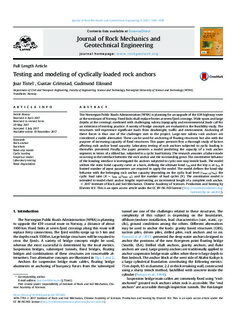| dc.contributor.author | Tistel, Joar | |
| dc.contributor.author | Grimstad, Gustav | |
| dc.contributor.author | Eiksund, Gudmund Reidar | |
| dc.date.accessioned | 2017-12-18T09:30:50Z | |
| dc.date.available | 2017-12-18T09:30:50Z | |
| dc.date.created | 2017-12-11T14:30:54Z | |
| dc.date.issued | 2017 | |
| dc.identifier.citation | Journal of Rock Mechanics and Geotechnical Engineering. 2017, 9 (6), 1010-1030. | nb_NO |
| dc.identifier.issn | 1674-7755 | |
| dc.identifier.uri | http://hdl.handle.net/11250/2472305 | |
| dc.description.abstract | The Norwegian Public Roads Administration (NPRA) is planning for an upgrade of the E39 highway route at the westcoast of Norway. Fixed links shall replace ferries at seven fjord crossings. Wide spans and large depths at the crossings combined with challenging subsea topography and environmental loads call for an extension of existing practice. A variety of bridge concepts are evaluated in the feasibility study. The structures will experience significant loads from deadweight, traffic and environment. Anchoring of these forces is thus one of the challenges met in the project. Large-size subsea rock anchors are considered a viable alternative. These can be used for anchoring of floating structures but also with the purpose of increasing capacity of fixed structures. This paper presents first a thorough study of factors affecting rock anchor bond capacity. Laboratory testing of rock anchors subjected to cyclic loading is thereafter presented. Finally, the paper presents a model predicting the capacity of a rock anchor segment, in terms of a ribbed bar, subjected to a cyclic load history. The research assumes a failure mode occurring in the interface between the rock anchor and the surrounding grout. The constitutive behavior of the bonding interface is investigated for anchors subjected to cyclic one-way tensile loads. The model utilizes the static bond capacity curve as a basis, defining the ultimate bond τbu and the slip s1 at τbu. A limited number of input parameters are required to apply the model. The model defines the bond-slip behavior with the belonging rock anchor capacity depending on the cyclic load level (τmax cy/τbu), the cyclic load ratio (R = τmin cy/τmax cy), and the number of load cycles (N). The constitutive model is intended to model short anchor lengths representing an incremental length of a complete rock anchor. | nb_NO |
| dc.language.iso | eng | nb_NO |
| dc.publisher | Elsevier | nb_NO |
| dc.rights | Attribution-NonCommercial-NoDerivatives 4.0 Internasjonal | * |
| dc.rights.uri | http://creativecommons.org/licenses/by-nc-nd/4.0/deed.no | * |
| dc.title | Testing and modeling of cyclically loaded rock anchors | nb_NO |
| dc.type | Journal article | nb_NO |
| dc.type | Peer reviewed | nb_NO |
| dc.description.version | publishedVersion | nb_NO |
| dc.source.pagenumber | 1010-1030 | nb_NO |
| dc.source.volume | 9 | nb_NO |
| dc.source.journal | Journal of Rock Mechanics and Geotechnical Engineering | nb_NO |
| dc.source.issue | 6 | nb_NO |
| dc.identifier.doi | 10.1016/j.jrmge.2017.07.005 | |
| dc.identifier.cristin | 1525750 | |
| dc.description.localcode | © 2017 Institute of Rock and Soil Mechanics, Chinese Academy of Sciences. Production and hosting by Elsevier B.V. This is an open access article under the CC BY-NC-ND license (http://creativecommons.org/licenses/by-nc-nd/4.0/). | nb_NO |
| cristin.unitcode | 194,64,91,0 | |
| cristin.unitname | Institutt for bygg- og miljøteknikk | |
| cristin.ispublished | true | |
| cristin.fulltext | original | |
| cristin.qualitycode | 1 | |

